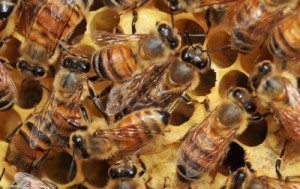Bees have been disappearing at an alarming rate and continue to vanish without a trace. Why should anyone care? Well, they matter a lot more than most people think. Bees are the overwhelmingly dominant pollinator for most food crops. Native bees in the United States are responsible for pollinating over $15 billion worth of agricultural commodities annually. However, native bee populations are in decline due to habitat loss. At the same time, managed colonies of European honey bees have suffered a 50% decline over the past few decades. Numerous other pollinating insects are facing the same fate.
As the spring planting season is upon us, it’s exciting to think about all the wonderful produce we will have this summer. But, without pollinators many of these crops would not be available. The majority of fruit and vegetable food sources we eat are dependent on insect pollinators. One of every three bites of food Americans consume comes from a plant visited by bees or other pollinators.
As declining numbers of farmers work to meet the needs of an increasing population, they are forced to make choices on alternative to chemicals for pest control. “Good bug blends” of flowers can help attract pollinators as well as beneficial insects that suppress harmful pests. Establishment of these meadows can be done on a small or large scale and in any habitat. One approach to “bringing back the pollinators” is to intercrop with blooming plants that attract insects. Selecting a diversity of plants with different flower sizes, shapes and colors, as well as various plant heights and growth habits, will encourage the greatest numbers of pollinators. It is important to provide a continuous source of pollen and nectar throughout the growing season. At minimum, strive for three species to be blooming at any one time; the greater the diversity the better.
To enhance the garden, choose flowering plants that also provide shelter for beneficial insects. Many companion plants are suitable habitat for predators and parasitoids. Research in Florida has demonstrated that predatory minute pirate bugs can build to high numbers in sunflowers. The favorite food of minute pirate bugs is Western flower thrips. So, planting sunflowers on the perimeter of vegetable crops, such as peppers, can greatly reduce the damage caused by the thrips. Similar results were found with the planting of sorghum to attract beneficial mites and intercropping with buckwheat to house syrphid flies and parasitoid wasps. The garden vegetables experienced fewer spider mite, whitefly and aphid problems. Crimson clover, Hairy vetch and cosmos are other annual seed crops that can aid in attracting pollinators and harboring beneficial insects.
Insectary meadows can be created in the landscape and along roadways, not just in the garden. For more permanently planted areas, native wildflowers, grasses and woody plants serve as larval host plants for butterflies, and also provide nesting and overwintering sites for bumble bees, predacious beetles and other beneficial insects. Native perennial wildflowers such as blanketflower, tickseed, black-eyed Susan, partridge pea, narrowleaf sunflower, milkweed, beebalm, goldenrod and silkgrass can be installed in the spring as potted plants or seeded in the fall. Seeds require exposure to cold temperatures and damp conditions before germination can occur. In Florida, the best time is November to February.
Though grasses do not offer nectar or high-quality pollen, it is often useful to include at least one native bunch grass or sedge. Short, clump-forming grasses are preferable to large, spreading grasses. Hedgerow planting of woody species is a way to provide winter-blooming plants vital for supporting pollinators. Woody plants and grasses provide more than forage for pollinators, as many native bee species nest in the stems of plants or in the undisturbed ground underneath plantings. Suitable grasses include: beaked panicgrass, purple lovegrass, Muhly grass, broomsedge,little bluestem, wiregrass and toothache grass. Favored woody species that make good “beetle banks” include: fetterbush, American beautyberry, saw palmetto, Chickasaw plum, red maple, sparkleberry, Dahoon holly, redbud, blackgum, magnolia, buttonwood and sourwood.
Regardless of whether the objective is to establish herbaceous or woody vegetation, the time and effort spent on eradicating undesirable plants prior to planting will result in higher success rates in establishing the targeted plant community. Choose level, open sites that receive full sunlight and have limited weed populations. If perennial weeds are a problem, the use of herbicides that have no soil residual (e.g. glyphosate) may be necessary.
For more information on establishing planting for pollinators visit: www.xerces.org/pollinator.
- Sunshine in the Winter - December 20, 2024
- Helene’s Potential Impact on the Florida Coastal Wetlands - October 4, 2024
- April is Safe Digging Awareness Month - April 6, 2024

